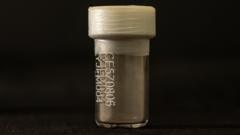The long-awaited lunar dust, regarded as "more precious than gold," recently arrived in the UK on loan from China, marking a significant moment in space exploration and international scientific collaboration. The samples, collected during China's Chang'e 5 mission in 2020, are now securely housed in a high-security facility in Milton Keynes, where they can be preserved from contamination.
Professor Mahesh Anand, the sole UK scientist chosen to work with this rare material, expressed immense honor in being granted access, as these lunar samples are the first of their kind returned to Earth since the Soviet Union's mission in 1976. "This is a great privilege," he stated, emphasizing the extraordinary nature of the samples.
In the quest to unlock the mysteries of the Moon's formation and its connection to Earth, Professor Anand's team will employ advanced techniques, including grinding and laser zapping, to analyze an incredibly small 60mg of dust. This mission holds the potential for groundbreaking insights into early planetary history, reinforcing the theory that the Moon originated from debris cast off during a collision between Earth and a Mars-sized planet billions of years ago.
The lunar dust was harvested from a volcanic region known as Mons Rümker and transported back to Earth in a capsule that landed in Inner Mongolia. During a ceremonial handover in Beijing, Professor Anand received the samples alongside international scientists from Russia, Japan, Pakistan, and Europe, illustrating an evolving commitment to global scientific collaboration.
At the research lab, stringent measures are taken to maintain a pristine environment free from Earthly contaminants, with staff donning specialized gear before entering the high-security rooms containing the samples. The tiny vials holding the lunar dust, roughly the size of jewelry containers, elicit awe for their extraordinary cosmic journey.
Technicians like Kay Knight and Sasha Verchovsky are eager yet apprehensive as they prepare to work on the samples. Their tasks include cutting the grains and conducting interactive analytical processes to investigate their composition, focusing on essential elements like carbon, nitrogen, and noble gases. Anand and his team have a year to maximize their research on the samples, which might ultimately lead to their destruction due to the analysis process.
China's advancements since the Chang'e 5 mission, including the 2024 Chang'e 6 launch that plans to return further samples, hint at an exciting future for lunar science. Professor Anand remains hopeful about fostering long-term collaborations between China and international researchers, an aspiration rooted in the rich legacy of scientific discovery forged by earlier lunar missions.


















